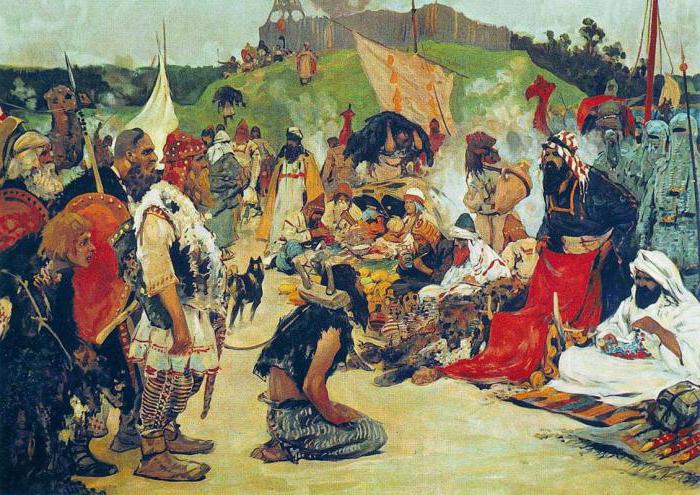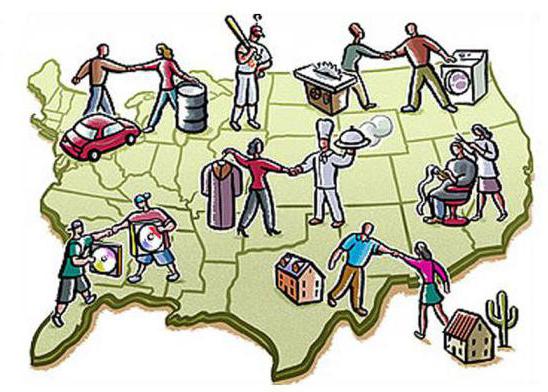In the process of the formation of civilization, man moves from the simple consumption of gifts of nature to the production of necessary products. There is an economy. Historically, there are two of its types: subsistence and commodity economy. They also call the third type - planned economy.
What it is?
A commodity economy is a type of economic relationship in which a manufacturer makes a product to meet the needs of a buyer. Delivery of products is carried out through exchange (barter or trade). Thanks to this organization of the economy, diversified development of production takes place. The division of labor is increasing, leading to the improvement of technology. Modernization causes an increase in productivity, resulting in an increase in production. The choice of goods is expanding, which is sent to the market for exchange for other products.

Before the transition to a commodity economy, humanity learned to live by a more primitive method of production - subsistence farming. Without information about the characteristic features, pluses and minuses, it is impossible to comprehend the presentation of the presentation.
Natural economy
The first organization for creating the necessary things was subsistence farming. This method of manufacturing products is based on the manufacturer's own provision of their needs. That is, household items are created for their own needs. Nothing is sold and nothing is bought.
Subsistence economy characterizes the level of economic development in a feudal society. Some features are reflected in modern historical conditions in developed and underdeveloped countries. The desire of a separate region or business enterprise for self-sufficiency leads to a revival of subsistence farming. The economic policy of the state, aimed at creating the necessary goods within the country, was called autarky.
Features of subsistence farming
The main features of subsistence farming:
- the predominance of manual labor without its division;
- isolation, denial of connections with other associations;
- formula for economic development “production-distribution-consumption”;
- the manufactured product does not become a commodity; lack of commodity-money relations;
- production is based on established traditions, which are forbidden to improve or cancel.

The main minus natural production consists in the fact that it impedes the development of productive activities, the expansion of the diversity of manufactured items. You can distinguish between subsistence and commodity economy according to the following criteria: isolation or openness of the economy; stagnation or progress in the division of labor; methods of solving the issue of meeting needs.
The main features of the commodity economy
In the transition to the commercial type of production, the main features change significantly. Commodity management is characterized by the following features:
- There is a transition to improved implements of production. Primitive physical labor is being replaced by increasingly sophisticated technical innovations, from the potter’s wheel to the use of computerized robots.
- The economic system is gaining openness. The manufacturer creates its products for sale to others. The finished product or product is sent to the market. Here he finds his buyer-consumer. Each manufacturer needs to receive goods to meet their requirements in food, clothing, housing, and so on.
- There is a deepening in the division of labor. If the artisan in the workshop performs all operations for the production of the product from the procurement of raw materials to the finished product, as a result of technological progress, specialization appears at each stage of the production of goods.
- The formula for the development of the economy is changing: “production-exchange-consumption”. A link appears between the producer and the consumer in the form of a market. On the market, the seller exchanges the goods for money; he spends the money received on the item he needs. The market plays the role of a production regulator, it is he who shows which product should be produced (it is in demand) and which is not.

The formation of the commodity economy
The formation of the transition from subsistence to commodity economy begins with the division of labor. Three stages are known in the history of mankind. Even with the primitive system, the first division of labor occurs: agricultural labor is separated from livestock production. The next stage: the occupation of the craft is separated from agriculture and animal husbandry, which creates more favorable conditions for the emergence of a commodity economy. Performance increase, increase of manufactured goods leads to the third round in the division of labor: a category of people stands out who produces nothing, but deals only with trade. The merchants are emerging.
The basis of the commodity economy: goods and money
The benefit that has arisen as a result of labor activity and aimed at meeting the needs of a person becomes a commodity. If an object appears without the participation of a person (sunlight, for example), then this cannot be the subject of sale. If nobody needs the good, then this is not a commodity either. If a thing is made for itself, and not for exchange, then it is not for sale. Therefore, it is not considered a product.

The most important product criteria are consumer and exchange value. Consumer value is the ability of a product to satisfy a need. Exchange is the ability of one subject to value the value of another. Barter exchange of goods confirms this statement. But such a deal is not always convenient. To carry out barter exchanges, you should be in the same place with the required quantity of goods from at least two manufacturers.
After some time, the equivalent value of any item was required. So there was money. Exchange acquires the formula “commodity-money-commodity”. Money is turning into a means of payment for goods and services, becoming the main measure of the value of goods. The original form in the form of bullion from precious metals has been replaced by coins and paper bills. In the modern world, plastic cards are common. Now economic theory recognizes in money everything that performs the functions of payments and the accumulation of financial resources.
Reasons for the origin of the commodity economy
The emergence of a commodity economy is associated with the division of labor. This is considered the first cause of nucleation. At the present stage, the following forms of division of labor are distinguished:
- Inside the enterprise - the sole division that occurs as a result of splitting into varieties of activity.
- Between parts of one industry - private separation - the formation of specialized sub-sectors.
- Between large blocks is the international or general division of labor (industry and agriculture).

The development of commodity economy is associated with the transformation of products into goods. The separate economy of an individual producer forces it to produce a product not only for itself. To continue his life he needs to acquire other goods. When their manufacture cannot be made on their own farm, there is a desire to produce more than a certain product, in order to subsequently exchange it for other items.
Types of production of goods
In science, there are two main types of commodity production.The first in the historical arena appears simple commodity economy. The goods are made by artisans and peasants. At the same time there is subsistence farming, which occupies a dominant position. This kind is characteristic of a slave and feudal society. It remains noticeable at the initial stage of the capitalist level of development.
The technique is being improved, the economy is developing, the commodity economy is growing into the second type - developed commodity production. It quickly takes leading positions and covers the main areas of economic development in the formation of capitalist relations. All goods produced are transformed into goods. Wage labor becomes the object of sale.
Ownership Influence
The formation of a certain type of commodity economy depends on the form of ownership of production. The maximum return is obtained if the creator of the goods is a private owner. Although only the form of ownership does not regulate the formation of the type of production (under feudalism, personal ownership of land does not allow abandoning subsistence farming). For the development of the economy it is necessary that private property and commodity-market economy are harmoniously combined.

At the turn of the XX-XXI centuries, a non-market sector of the national economy appeared. This includes the production of goods that do not generate income: the defense complex, scientific research, compulsory types of education.
Commodity Benefits
The development of capitalist economy has as its main goal profit-making. The more broth obtained, the better. There are no boundaries. Benefits are expressed in methods for achieving this goal.
- The maximum profit can be obtained only by minimizing production costs.
- It is possible to reduce costs by increasing labor productivity using the inventions of the scientific and technological revolution.
- Manufacturers of goods compete with each other for receiving consumer money (they independently answer the main questions of the economy: what to produce, how to do it and for whom).
The commodity-money economy is keen and quick to respond to customer demand. The slightest change in needs forces to reduce the production of one product, increasing the quantity of another. The reallocation of resources. This regulates the structure of the state economy, improving the mechanism of consumption of funds.
Disadvantages of the commodity economy
Pros are converted into cons when denying the main provisions of the commodity economy. Competition between manufacturers leads to the desire of the largest of them to monopolize. This contributes to the establishment of inflated prices, the rejection of the achievements of progress in technology and science, the destruction of market relations.
In an effort to maximize profits, the commodity form of the economy is not interested in preserving natural resources (even irreplaceable). The result is environmental pollution, depletion of reserves. Social justice is contrary to the laws of market relations. Producers take into account the interests of only those consumers who are solvent and can purchase goods. They do not take into account other opinions.
The essence of the commodity economy today is analyzed, improved, modeled. This is due to his progress and to new discoveries in economic science.






